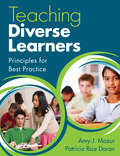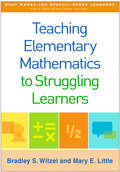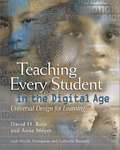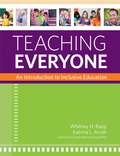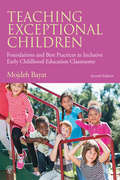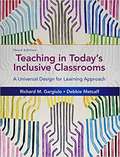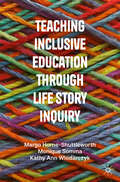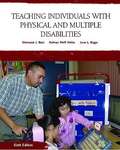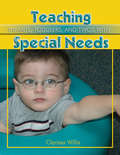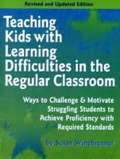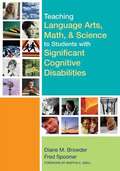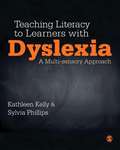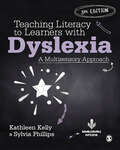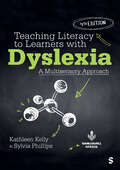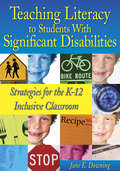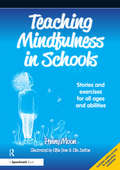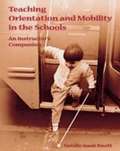- Table View
- List View
Teaching Deaf And Hard Of Hearing Students: Content, Strategies, And Curriculum
by David A. Stewart Thomas N. KluwinThis highly practical reference for both pre-service and in-service teachers of the deaf and hard of hearing covers methods of teaching and other issues related to the teaching of deaf students. Teaching Deaf and Hard of Hearing Students takes a practical look at the challenges of teaching subject matter to deaf children. The book gives suggestions about what teachers can do in the classroom that will make a positive difference in how their deaf students learn. It emphasizes providing teachers with a framework to design instructions that meet the educational needs of their deaf students. The principles upon which instructional planning proceeds are applicable to deaf students at all grade levels; thus, the book is suitable for teachers at the elementary through high school levels. These principles are diverse but revolve around four central themes: 1) Creating authentic experiences; 2) Integrating vocabulary development; 3) Creating opportunities for self-expression; and 4) Providing deaf role models. When applicable, distinctions are made between the various instructionalroles of teachers in self-contained classrooms, resource room teachers, and itinerant teachers, as well as general education teachers who have deaf students in their classrooms. Issues relating to diversity, discipline, and disabilities are reviewed from a pragmatic perspective. Ideas are then presented about how teachers can address these issues through instruction. Finally, strategies are provided for involving the family in the education of their deaf children, including exercises for increasing family awareness of the learning challenges their deaf children face. Practical ideas about how teachers can empower parents in the learning process are featured. Educators of deaf and hard of hearing students.
Teaching Diverse Learners: Principles for Best Practice
by Amy J. Mazur Patricia R. DoranPractical guidelines and strategies for meeting the needs of every student in your classroom! Based on current research, legislation, and best classroom practices, this comprehensive guide helps educators effectively teach students who are culturally and linguistically diverse as well as those who have or might have special education needs. The user-friendly book offers strategies, case studies, guiding questions, activities, and tools to help PreK–12 teachers: Understand key concepts, policies, and cultural issues Set up an effective, emotionally safe classroom Adapt curriculum, instruction, and assessment to make learning accessible Collaborate with fellow professionals, families, and communities
Teaching Elementary Mathematics to Struggling Learners
by Mary E. Little Bradley S. WitzelPacked with effective instructional strategies, this book explores why certain K-5 students struggle with math and provides a framework for helping these learners succeed. The authors present empirically validated practices for supporting students with disabilities and others experiencing difficulties in specific areas of math, including problem solving, early numeracy, whole-number operations, fractions, geometry, and algebra. Concrete examples, easy-to-implement lesson-planning ideas, and connections to state standards, in particular the Common Core standards, enhance the book's utility. Also provided is invaluable guidance on planning and delivering multi-tiered instruction and intervention.
Teaching English Learners in Inclusive Classrooms
by Elda DuránTeachers and teacher trainers will find this clear, well-written text to be an invaluable resource in addressing the needs of myriad and unique students, especially those with disabilities.
Teaching Every Student in the Digital Age: Universal Design for Learning
by David Rose Anne MeyerThis book presents principles and applications of Universal Design for Learning (UDL), a research-based framework for responding to individual learning differences and a blueprint for the modern redesign of education. Early chapters lay out the foundation of UDL, describing neuroscience research on learning differences, the uses of digital media in the classroom, and the creation of flexible curricula. Later chapters show how to set appropriate goals for each student, how to choose methods and materials, and how to assess students' progress. The authors are cofounders and codirectors of the Center for Applied Special Technology. Annotation c. Book News, Inc. , Portland, OR (booknews. com)
Teaching Everyone: An Introduction to Inclusive Education
by Whitney H. Rapp Katrina L. ArndtWhitney Rapp & Katrina Arndt developed Teaching Everyone, the first text that fully prepares teachers to see past disability labels and work with all students' individual needs and strengths. Accessible and forward-thinking, this inclusive special education text will get K-12 teachers ready to work effectively within today's schools and meet the learning needs of a wide range of students.
Teaching Exceptional Children: Foundations and Best Practices in Early Childhood Special Education
by Mojdeh BayatTeaching Exceptional Children is the ideal textbook for introductory graduate and undergraduate courses on early childhood special education and teaching in inclusive classrooms. Bayat’s clear and accessible writing, the text’s visually appealing design, and the focused pedagogy included in each chapter help make it possible for students and instructors to cover a significant amount of material. This powerful text identifies specific behavioral characteristics and presents theoretical information grounded in neuroscience and child development research for a wide range of disabilities. Chapters provide research-based best practices for effectively working with children with various disabilities in inclusive classrooms. This third edition has been fully updated with recent research and includes new sections on Universal Design for Learning, adaptations, technology, and common challenges in inclusive early childhood classrooms. This book is also accompanied by a robust collection of online resources for instructors and students, providing full support, including a Companion Website featuring an Instructor's Manual with additional ideas for assignments and projects, web and video links with reflection questions, a test bank, and lecture slides; and an eBook+ offering interactive links to videos, glossary terms, and more!
Teaching Exceptional Children: Foundations and Best Practices in Inclusive Early Childhood Education Classrooms
by Mojdeh BayatTeaching Exceptional Children is an ideal textbook for introductory graduate and undergraduate courses on early childhood special education and teaching in inclusive classrooms. Bayat’s clear and accessible writing, a visually appealing design, and focused pedagogy in each chapter help make it possible to cover a significant amount of material. This powerful text identifies specific behavioral characteristics and presents theoretical information grounded in neuroscience and child development research for a wide range of disabilities. Research-based best practices for effectively working with children with various disabilities in inclusive classrooms are provided in each chapter. The second edition has been fully updated based on the DSM-5, and includes new sections on contemporary issues in inclusion of children with disabilities in early childhood classrooms, such as challenging behaviors, using technology, at-risk children, promoting mental health, and family issues. A robust pedagogical program, along with online resources for instructors and students, provides full support, including: Chapter Objectives and Key Terms help frame each chapter Discussion, Critical Thinking, Essay/Short Answer, and Review Questions at the beginning, throughout, and concluding chapters prompt students to fully engage with the material Homework/Field Assignments provide opportunities for students to apply their knowledge to real-world situations Real-Life Vignettes illustrate concepts in action Color Photos, Figures, and Tables clarify concepts in a visually engaging way Recommended Resources and References offer guidance for further study www.routledge.com/9781138802209 includes a link to an Instructor's Manual with ideas for assignments and projects, grading and assessment rubrics, and learning outcomes (see the e-Resource tab). A full companion website (www.routledge.com/cw/bayat) is under construction and will provide video and web links, discussion questions, test bank, PowerPoints, and a sample syllabus.
Teaching Foundation Mathematics: A Guide for Teachers of Older Students with Learning Difficulties (nasen spotlight)
by Nadia Naggar-SmithThis fully photocopiable resource will provide essential materials for anyone teaching pre-entry or foundation Maths in secondary schools and further education. Teaching Foundation Mathematics is developed to provide age appropriate material for adult learners with moderate to severe learning difficulties and/or disabilities and for children, over twelve, with special needs. It will also prove useful to teachers training to work with these learners. Thirty ready-to-use lessons are at your fingertips in this book, complete with tutor’s notes, teaching objectives, detailed lesson plans and photocopiable worksheets, where appropriate. The lessons are divided into three areas – number, shape and measure.
Teaching In Today's Inclusive Classrooms: A Universal Design For Learning Approach (Mindtap Course List)
by Richard GargiuloTEACHING IN TODAY'S INCLUSIVE CLASSROOMS: A UNIVERSAL DESIGN FOR LEARNING APPROACH, 3rd Edition is a concise, accessible, and current text for the Introduction to Inclusive Teaching course. It is the only inclusion textbook available with a consistent, integrated emphasis on Universal Design for Learning (UDL)�an important, contemporary educational philosophy focused on using strategies and tools to help ALL students by accommodating their differences. Aligned with InTASC and CEC standards, this text also provides foundational information about children with disabilities who are included in today's classrooms, and the most effective strategies for teaching them alongside their typically developing peers. Featuring new material on Common Core State Standards, case studies, and sound research-based teaching and learning strategies, this hands-on text offers you a practical, flexible framework for effective instruction, classroom management, assessment, and collaboration in today's diverse classrooms.
Teaching Inclusive Education through Life Story Inquiry
by Margo Horne-Shuttleworth Monique Somma Kathy Ann WlodarczykThis practical textbook is designed as core reading for pre-service and in-service teachers and mental health practitioners in upper level Education and Psychology programs. Key concepts addressed in this case study collection include Inclusive Education as an overarching framework through the lens of Critical Disability Studies, Intersectionality and Mental Health. It portrays the first-hand accounts and lived experiences of individuals with disabilities to further understand the impact students’ classroom experiences have beyond their early school years. These accounts along with commentaries from education and health professionals inform evidence-based recommendations for educators and practitioners on prevention and intervention practices for school age children with disabilities. Readers will be prompted to consider their experiences and perspectives through chapter specific discussion-based and reflective questions that are designed to incorporate key concepts addressed throughout the text.
Teaching Individuals With Physical and Multiple Disabilities (Sixth Edition)
by Sherwood J. Best Kathryn Wolff Heller June L. BiggeComprehensive and unique, this text provides special educators and others education professionals with the knowledge and strategies for creating meaningful educational experiences for students with physical, health, or multiple disabilities. It is the only text published that specifically addresses the educational and psychosocial needs of students with physical or health impairments who do not necessarily have cognitive disabilities and explains the psychosocial impact of disability including those disabilities that are degenerative and terminal in nature. It teaches key knowledge and strategies for creating meaningful educational experiences for students with physical, health, or multiple disabilities and illustrates how assessment and curriculum accommodations and modifications support students with physical or multiple disabilities to reach their highest potential. New to this Edition! NEW! Features a completely redesigned model for planning and designing courses of study for students with disabilities that is aligned with core academic curriculum - found in the chapter on curricular options (Ch. 5) and modeled throughout the text. Familiarizes readers with the theory on which text coverage is based and gives them a structure on which to "hang" current and future knowledge. NEW! Includes the most updated information on federal legislation - Summarizes the key aspects of NCLB and IDEA (Ch. 1) Describes mandated assessment and appropriate accommodations and modifications. NEW! Redesigned transition content (Ch. 12) - emphasizes self-determination as a guiding factor developing student outcomes. NEW! Photos and illustrations throughout the text - Created specifically for this text, with enhanced chapter opening photos. Enhance the narrative throughout and the uniqueness of the text overall. NEW! For faculty an Instructor's Manual is now available - to help structure their course and make the content more meaningful to their students.
Teaching Infants, Todders & Twos with Special Needs
by Clarissa WillisPlacing children with special needs in environments that include typically developing peers has become commonplace as continuing research confirms that all children benefit and learn from each other as well as from their teachers. Teaching Infants, Toddlers, and Twos with Special Needs is written for all teachers and directors who work with infants, toddlers, and twos, including special educators and educators working with typically developing children. This book specifically addresses the needs of children with developmental delays, as well as children at risk for developing special needs. Each chapter in Teaching Infants, Toddlers, and Twos with Special Needs includes information about how young children learn. The strategies and adaptations in each chapter are easy to use and apply to all children. Examples are presented for managing the physical environment and for teaching skills that will enhance the overall development of infants, toddlers, and twos with special needs.
Teaching Kids with Learning Difficulties in the Regular Classroom: Ways to Challenge and Motivate Struggling Students to Achieve Proficiency with Required Standards
by Susan WinebrennerProven ways to help special education, "slow", and "remedial" students learn and achieve.
Teaching Language Arts, Math, and Science to Students With Significant Cognitive Disabilities
by Diane M. Browder Fred SpoonerUnder NCLB, students with severe disabilities are expected to make progress on state academic content standards in language arts, math, and science. But what material should educators teach from these three content areas, and how should they teach it? With this groundbreaking textbook, future educators will have the answers they need. The first major research-to-practice resource on this critical topic, this text goes beyond functional and access skills and shows educators how to make the general curriculum accessible to students of all ages with significant cognitive disabilities. Twenty-five of the best-known researchers in the field prepare educators to - adapt lessons in language arts, math, and science for students with disabilities - identify meaningful instructional content - create effective learning environments through instructional procedures such as peer tutoring, cooperative learning, and co-teaching - set appropriate expectations for student achievement - align instruction with state content standards and alternate assessment For each content area, future teachers will get a solid research foundation blended with teaching examples, guidelines, and helpful figures and tables. A timely textbook for pre-service educators--and a valuable reference for in-service teachers seeking guidance--this important resource will raise expectations for students with disabilities and ensure their progress in key academic areas. Learn how to teach - Language Arts. Move beyond sight-word recognition and teach the literacy components identified by the National Reading Panel - Math. Help students learn higher-level math concepts such as problem solving, reasoning, connections, and representations, as well as functional skills - Science.
Teaching Literacy to Learners with A Multi-sensory Approach Dyslexia
by Kathleen KellyProviding a structured programme for teaching literacy to children and young people with dyslexia and specific literacy difficulties, this book makes explicit links between theory, research and practice. It offers a structured, cumulative, multi-sensory teaching programme for learners with dyslexia, and draws attention to some of the wider aspects of the learning styles and differences of learners with dyslexia such as memory, information processing and automaticity. The book discusses: - the rationale for a structured multi-sensory approach - the development of phonological, reading, writing and spelling skills - working with learners who have English as an Additional Language (EAL) - lesson structure and lesson planning - alphabet and dictionary skills - memory work and study skills - teaching the programme to groups - ideas for working with young children Designed to help support any learner, ages 5 to 18, with dyslexia or specific learning difficulties, 'the authors encourage the use of the programme as part of the specialist teaching of learners with dyslexia whilst giving strategies for everyday teaching to not only develop literacy but to put learners with dyslexia in control of their own learnin the authors encourage the use of the programme as part of everyday teaching to not only develop literacy but to put dyslexic learners in control of their own learning. There are tried and tested strategies and activities provided, which the reader can use to support their literacy work. Particularly useful for teachers working with learners who have special educational needs and specifically those with dyslexia, this book contains everything you need to help improve and develop the literacy skills of the learners in your setting.
Teaching Literacy to Learners with Dyslexia: A Multi-sensory Approach
by Kathleen Kelly Sylvia PhillipsThe Second Edition of this bestselling book provides a structured multi-sensory programme for teaching literacy to children and young people from 5-18 with dyslexia and other specific literacy difficulties. Supported by a wealth of resources available online and updated throughout, the new edition now includes a brand new section on Implementing the Accelerated Programme for learners who have already acquired some literacy skills. This includes: A placement test to indicate whether the programme is appropriate A diagnostic assessment procedure to determine where the learner should begin on the Accelerated Programme Examples of lesson plans, reading cards and spelling cards to help teachers prepare resources for their students With tried and tested strategies and activities this book continues to provide everything you need to help improve and develop the literacy skills of learners in your setting including; the rationale for a structured multi-sensory approach the development of phonological, reading, writing and spelling skills working with learners who have English as an Additional Language (EAL) lesson structure and lesson-planning alphabet and dictionary skills memory work and study skills teaching the programme to groups ideas for working with young children.
Teaching Literacy to Learners with Dyslexia: A Multi-sensory Approach
by Kathleen Kelly Sylvia PhillipsThe second edition of this bestselling book provides a structured multi-sensory programme for teaching literacy to children and young people from 5-18 with dyslexia and other specific literacy difficulties. Supported by a wealth of resources available online and updated throughout, the new edition now includes a brand new section on Implementing the Accelerated Programme for learners who have already acquired some literacy skills. This includes: · A placement test to indicate whether the programme is appropriate · A diagnostic assessment procedure to determine where the learner should begin on the Accelerated Programme · Examples of lesson plans, reading cards and spelling cards to help teachers prepare resources for their students. With tried and tested strategies and activities this book continues to provide everything you need to help improve and develop the literacy skills of learners in your setting including; · the rationale for a structured multi-sensory approach · the development of phonological, reading, writing and spelling skills · working with learners who have English as an Additional Language (EAL) · lesson structure and lesson-planning · alphabet and dictionary skills · memory work and study skills · teaching the programme to groups · ideas for working with young children.
Teaching Literacy to Learners with Dyslexia: A Multisensory Approach
by Kathleen Kelly Sylvia PhillipsThis bestselling book for teaching literacy to children and young people aged 4–16 years with dyslexia and other specific literacy difficulties has been fully updated for its third edition. Providing a structured multi-sensory programme, ‘Conquering Literacy’, that includes placement tests, well-established strategies and examples of lesson planning, teaching activities, and reading, spelling and literacy concept cards, this book is an essential practical resource for teachers. This new edition includes: an additional section for learners who need an individualised, structured programme at an advanced stage (Stage II); a section on planning shorter, targeted interventions for learners with a particular difficulty e.g. spelling, revising; three new chapters on teaching reading, spelling and writing within mainstream classrooms using strategies which are successful with learners with dyslexia downloadable teaching resources available from the companion website.
Teaching Literacy to Learners with Dyslexia: A Multisensory Approach
by Kathleen Kelly Sylvia PhillipsThis bestselling book for teaching literacy to children and young people aged 4–16 years with dyslexia and other specific literacy difficulties has been fully updated for its third edition. Providing a structured multi-sensory programme, ‘Conquering Literacy’, that includes placement tests, well-established strategies and examples of lesson planning, teaching activities, and reading, spelling and literacy concept cards, this book is an essential practical resource for teachers. This new edition includes: an additional section for learners who need an individualised, structured programme at an advanced stage (Stage II); a section on planning shorter, targeted interventions for learners with a particular difficulty e.g. spelling, revising; three new chapters on teaching reading, spelling and writing within mainstream classrooms using strategies which are successful with learners with dyslexia downloadable teaching resources available from the companion website.
Teaching Literacy to Learners with Dyslexia: A Multisensory Approach
by Kathleen Kelly Sylvia PhillipsThis bestselling book for teaching literacy to children and young people aged 4-16 years with dyslexia and other specific literacy difficulties has been fully updated for its fourth edition. Providing a structured multisensory programme, ‘Conquering Literacy’, that includes placement tests, well-established strategies and examples of lesson planning, teaching activities, and reading, spelling and literacy concept cards, this book is an essential practical resource for teachers. This new edition includes: • 51 new activities (online) to support the delivery of the Accelerated Programme. • A new chapter on co-occurring difficulties and the implications for teaching literacy using Conquering Literacy. • Additional examples and case studies. • New resources within the book itself, to support the teacher in delivering the lessons. • A variety of structured reading materials to develop reading comprehension for students working at Stage 2 of the programme.
Teaching Literacy to Learners with Dyslexia: A Multisensory Approach
by Kathleen Kelly Sylvia PhillipsThis bestselling book for teaching literacy to children and young people aged 4-16 years with dyslexia and other specific literacy difficulties has been fully updated for its fourth edition. Providing a structured multisensory programme, ‘Conquering Literacy’, that includes placement tests, well-established strategies and examples of lesson planning, teaching activities, and reading, spelling and literacy concept cards, this book is an essential practical resource for teachers. This new edition includes: • 51 new activities (online) to support the delivery of the Accelerated Programme. • A new chapter on co-occurring difficulties and the implications for teaching literacy using Conquering Literacy. • Additional examples and case studies. • New resources within the book itself, to support the teacher in delivering the lessons. • A variety of structured reading materials to develop reading comprehension for students working at Stage 2 of the programme.
Teaching Literacy to Students With Significant Disabilities: Strategies for the K-12 Inclusive Classroom
by June E. DowningBreak down the barriers to successful literacy instruction and empower students with special needs with these insightful tips, tools, and examples.
Teaching Mindfulness in Schools: Stories and Exercises for All Ages and Abilities
by Penny MoonTeaching Mindfulness in Schools is a practical teaching toolkit for educators and all professionals concerned with the social and emotional wellbeing of children. The book offers clear introductions to the many aspects and benefits of mindfulness for young people, as well as a wealth of practical guidance and tools to support the teaching of mindfulness in the classroom. Key features include: a range of stimulus materials including artwork and poems to read one-on-one with a child or for whole-class teaching; lesson plans, worksheets and colouring sheets to support a huge range of activity types including physical, creative and sensory exercises so that there is material to suit all the children you work with; audio recordings of guided mindfulness exercises for use in the classroom, narrated by the author and available to purchasers via the Speechmark website. Penny Moon is the founder of A Quiet Place, with nearly three decades of experience in workshop facilitation, teaching, emotional and behaviour development, psychotherapy, complimentary medicine, educational therapeutics and child, parent and family support.
Teaching Orientation and Mobility in the Schools: An Instructor's Companion
by Natalie Isaak KnottTeaching Orientation and Mobility in the Schools: An Instructor's Companion offers orientation and mobility (O&M) instructors and professionals working with students with visual impairments insights and advice. The book offers creative instructional methods and practical strategies as well as useful forms and checklist.

